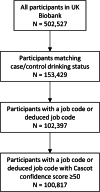Associations between occupation and heavy alcohol consumption in UK adults aged 40-69 years: a cross-sectional study using the UK Biobank
- PMID: 33622282
- PMCID: PMC7903617
- DOI: 10.1186/s12889-021-10208-x
Associations between occupation and heavy alcohol consumption in UK adults aged 40-69 years: a cross-sectional study using the UK Biobank
Abstract
Background: Understanding the relationship between occupation and alcohol use offers opportunities to provide health promotion programmes based on evidence of need. We aimed to determine associations between occupation and heavy alcohol consumption in working individuals aged 40-69 years.
Methods: A cross-sectional study was conducted using 100,817 people from the UK Biobank: 17,907 participants categorised as heavy drinkers, defined as > 35 units/week for women and > 50 units/week for men, and 82,910 drinking controls. Prevalence ratios (PRs) and 95% CIs were calculated for gender-specific heavy drinking in 353 occupations using Standard Occupational Classification, V.2000.
Results: Seventy-seven occupations were associated with level of alcohol consumption in drinkers. The largest ratios for heavy drinkers were observed for publicans and managers of licenced premises (PR = 2.81, 95%CI 2.52-3.14); industrial cleaning process occupations (PR = 2.09, 1.33-3.28); and plasterers (PR = 2.07, 1.66-2.59). Clergy (PR = 0.20, 0.13-0.32); physicists, geologists and meteorologists (PR = 0.40, 0.25-0.65); and medical practitioners (PR = 0.40, 0.32-0.50) were least likely to be heavy drinkers. There was evidence of gender-specific outcomes with the proportion of jobs associated with heavy drinking accounted for by skilled trade occupations being 0.44 for males and 0.05 for females, and 0.10 for males and 0.40 for females when considering managers and senior officials.
Conclusions: In the largest study of its kind, we found evidence for associations between a wider variety of occupations and the risk of heavy alcohol consumption than identified previously, particularly in females, although causality cannot be assumed. These results help determine which jobs and broader employment sectors may benefit most from prevention programmes.
Keywords: Alcohol use; Cross sectional study; Occupation; UK biobank.
Conflict of interest statement
None to declare.
Figures



Similar articles
-
Occupations associated with COPD risk in the large population-based UK Biobank cohort study.Occup Environ Med. 2016 Jun;73(6):378-84. doi: 10.1136/oemed-2015-103406. Epub 2016 Mar 21. Occup Environ Med. 2016. PMID: 27001997
-
Is alcohol consumption related to likelihood of reporting chronic widespread pain in people with stable consumption? Results from UK biobank.Pain. 2016 Nov;157(11):2552-2560. doi: 10.1097/j.pain.0000000000000675. Pain. 2016. PMID: 27437785
-
Alcohol is neither a risk factor nor a protective factor for sudden cardiac death and/or fatal ventricular arrhythmia: A population-based study with genetic traits and alcohol consumption in the UK Biobank.Heart Rhythm. 2024 Oct;21(10):1820-1826. doi: 10.1016/j.hrthm.2024.04.097. Epub 2024 May 1. Heart Rhythm. 2024. PMID: 38697272
-
Unravelling the alcohol harm paradox: a population-based study of social gradients across very heavy drinking thresholds.BMC Public Health. 2016 Jul 19;16:599. doi: 10.1186/s12889-016-3265-9. BMC Public Health. 2016. PMID: 27430342 Free PMC article.
-
Risk of newly developed atrial fibrillation by alcohol consumption differs according to genetic predisposition to alcohol metabolism: a large-scale cohort study with UK Biobank.BMC Med. 2023 Dec 21;21(1):509. doi: 10.1186/s12916-023-03229-3. BMC Med. 2023. PMID: 38129845 Free PMC article.
Cited by
-
The Impact of Taste Preference-Related Gene Polymorphisms on Alcohol Consumption Behavior: A Systematic Review.Int J Mol Sci. 2022 Dec 15;23(24):15989. doi: 10.3390/ijms232415989. Int J Mol Sci. 2022. PMID: 36555636 Free PMC article.
-
Exploring Ways to Reduce Heavy Drinking by Increasing Hope Among Midlife Women in Australia: Protocol for a Mixed Methods Study.JMIR Res Protoc. 2025 Jul 24;14:e72628. doi: 10.2196/72628. JMIR Res Protoc. 2025. PMID: 40707011 Free PMC article.
-
Effects of optimism and stage of change on alcohol use and problems among sexual minority men with HIV participating in a brief motivational interviewing intervention.J Subst Use Addict Treat. 2025 Feb;169:209599. doi: 10.1016/j.josat.2024.209599. Epub 2024 Dec 11. J Subst Use Addict Treat. 2025. PMID: 39672337 Free PMC article. Clinical Trial.
-
Risk Factors for Problematic Drinking in One's Thirties and Forties: A Longitudinal Analysis of the 1970 British Cohort Study.Int J Environ Res Public Health. 2022 Aug 26;19(17):10664. doi: 10.3390/ijerph191710664. Int J Environ Res Public Health. 2022. PMID: 36078379 Free PMC article.
-
Heavy Drinking by Occupation in Spain: Differences Between Weekdays and the Weekend.J Community Health. 2024 Apr;49(2):235-247. doi: 10.1007/s10900-023-01288-4. Epub 2023 Oct 15. J Community Health. 2024. PMID: 37839065
References
-
- HM Government . A minimum unit Price for alcohol. 2012.
-
- HM Government . Industrial Strategy. 2017.
Publication types
MeSH terms
Grants and funding
LinkOut - more resources
Full Text Sources
Other Literature Sources
Medical
Research Materials

